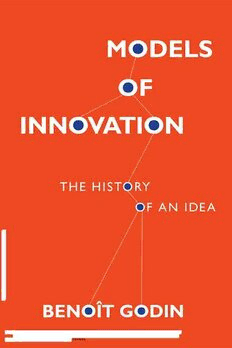
Models of Innovation: The History of an Idea PDF
Preview Models of Innovation: The History of an Idea
18:45:43. 18:45:43. Models of Innovation 18:45:43. Inside Technology Edited by Wiebe E. Bijker, W. Bernard Carlson, and Trevor Pinch A list of the series appears at the back of the book. 18:45:43. Models of Innovation The History of an Idea Benoît Godin The MIT Press Cambridge, Massachusetts London, England 18:45:43. © 2017 Massachusetts Institute of Technology All rights reserved. No part of this book may be reproduced in any form by any electronic or mechanical means (including photocopying, recording, or information storage and retrieval) without permission in writing from the publisher. This book was set in Stone Sans and Stone Serif by Toppan Best-set Premedia Limited. Printed and bound in the United States of America. Library of Congress Cataloging-in-Publication Data Names: Godin, Benoit, author. Title: Models of Innovation : The History of an Idea / Benoît Godin. Description: Cambridge, MA : MIT Press, [2017] | Series: Inside technology | Includes bibliographical references and index. Identifiers: LCCN 2016031366 | ISBN 9780262035897 (hardcover : alk. paper) Subjects: LCSH: Technological innovations. | Models and modelmaking--History-- 20th century. Classification: LCC T173.8 .G596 2017 | DDC 601--dc23 LC record available at https://lccn.loc.gov/2016031366 10 9 8 7 6 5 4 3 2 1 18:45:43. The mind may, as it appears to me, divide science into three parts. The first com- prises the most theoretical principles, and those more abstract notions whose appli- cation is either unknown or very remote. The second is composed of those general truths which still belong to pure theory, but lead, nevertheless, by a straight and short road to practical results. Methods of application and means of execution make up the third. Each of these different portions of science may be separately cultivated, although reason and experience show that none of them can prosper long, if it be absolutely cut off from the two others. —Alexis de Tocqueville, Democracy in America (1840) Development work is founded upon pure research done in the scientific depart- ment, which undertakes the necessary practical research on new products or pro- cesses as long as they are on the laboratory scale, and then transfers the work to special development departments which form an intermediate stage between the laboratory and the manufacturing department. —Kenneth Mees, “The Organization of Scientific Industrial Research” (1920) The principle of discovery first and utilization after is the oldest thing in man’s history. —Willis Whitney, “Science and Industry in the Coming Century” (1934) The theorist posits the basic concepts, the experimentalist tests reality, and the inventor converts the results to practical achievement. —William Rupert Maclaurin, “The Process of Technological Innovation” (1950) 18:45:43. 18:45:43. Acknowledgments The following chapters were published in the following journals. They are reproduced here, in a revised form, with permission of the publishers. Chapter 1: Benoît Godin (2014), “Invention, Diffusion and Linear Models of Innovation,” Journal of Innovation Economics & Management 15 (3): 11–37. Chapter 3: Benoît Godin (2011), “The Linear Model of Innovation: Mau- rice Holland and the Research Cycle,” Social Science Information 50 (3–4): 569–581. Chapter 4: Benoît Godin (2008), “In the Shadow of Schumpeter: William Rupert Maclaurin and the Study of Technological Innovation,” Minerva 46 (3): 343–360. Chapter 5: Benoît Godin (2006), “The Linear Model of Innovation: The Historical Construction of an Analytical Frame- work,” Science, Technology, and Human Values 31 (6): 639–667. Chapter 6: Benoît Godin and Joseph P. Lane (2013), “Pushes and Pulls: The Hi(Story) of the Demand Pull Model of Innovation,” Science, Technology and Human Values 38 (5): 621–654. Chapter 9: Benoît Godin (2009), “National Innova- tion System: The System Approach in Historical Perspective,” Science, Tech- nology, and Human Values 34 (4): 476–501. Chapter 10: Benoît Godin (2015), “Models of Innovation: Why Models of Innovation Are Models, or What Work Is Being Done in Calling Them Models?” Social Studies of Science 45 (4): 570–596. 18:46:04.
